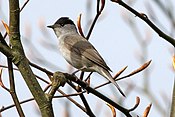Sylviidae
| Sylviidae | |
|---|---|

| |
| Eurasian blackcap (Sylvia atricapilla) | |
| Scientific classification | |
| Domain: | Eukaryota |
| Kingdom: | Animalia |
| Phylum: | Chordata |
| Class: | Aves |
| Order: | Passeriformes |
| Superfamily: | Sylvioidea |
| Family: | Sylviidae Leach, 1820 |
| Genera | |
|
See text | |
Sylviidae is a family of passerine birds that includes the typical warblers and a number of babblers formerly placed within the Old World babbler family. They are found in Eurasia and Africa.
Taxonomy and systematics
The
warblers[4]
A
Dohrn's thrush-babbler into Sylvia.[6] The split was not accepted by the British Ornithologists' Union on the grounds that "a split into two genera would unnecessarily destabilize nomenclature and results in only a minor increase in phylogenetic information content."[7]
| ||||||||||||||||||||||||||||||||||||||||||||||||
| Phylogeny based on a study of the babblers by Cai and colleagues published in 2019.[8][9] |
List of species
The family Sylviidae has undergone several revisions since the above phylogeny was published. As of early 2024, the
International Ornithological Committee (IOC) recoganizes these 32 species divided among two genera:[10]
This list is presented according to the IOC taxonomic sequence and can also be sorted alphabetically by common name and binomial.
| Genus | Common name | Binomial name | IOC sequence |
|---|---|---|---|
Sylvia Scopoli, 1769
|
Eurasian blackcap | Sylvia atricapilla | 1 |
| Garden warbler | Sylvia borin | 2 | |
| Dohrn's warbler | Sylvia dohrni | 3 | |
| Abyssinian catbird | Sylvia galinieri | 4 | |
| Bush blackcap | Sylvia nigricapillus | 5 | |
| African hill babbler | Sylvia abyssinica | 6 | |
| Rwenzori hill babbler | Sylvia atriceps | 7 | |
Curruca Bechstein, 1802
|
Barred warbler | Curruca nisoria | 8 |
| Layard's warbler | Curruca layardi | 9 | |
| Banded parisoma | Curruca boehmi | 10 | |
| Chestnut-vented warbler | Curruca subcoerulea | 11 | |
| Lesser whitethroat | Curruca curruca | 23 | |
| Brown parisoma | Curruca lugens | 13 | |
| Yemen warbler | Curruca buryi | 14 | |
| Arabian warbler | Curruca leucomelaena | 15 | |
| Western Orphean warbler | Curruca hortensis | 16 | |
| Eastern Orphean warbler | Curruca crassirostris | 17 | |
| African desert warbler | Curruca deserti | 18 | |
| Asian desert warbler | Curruca nana | 19 | |
| Tristram's warbler | Curruca deserticola | 20 | |
| Menetries's warbler | Curruca mystacea | 21 | |
| Rüppell's warbler | Curruca ruppeli | 22 | |
| Cyprus warbler | Curruca melanothorax | 23 | |
| Sardinian warbler | Curruca melanocephala | 24 | |
| Western subalpine warbler | Curruca iberiae | 25 | |
| Moltoni's warbler | Curruca subalpina | 26 | |
| Eastern subalpine warbler | Curruca cantillans | 27 | |
| Common whitethroat | Curruca communis | 28 | |
| Spectacled warbler | Curruca conspicillata | 29 | |
| Marmora's warbler | Curruca sarda | 30 | |
| Dartford warbler | Curruca undata | 31 | |
| Balearic warbler | Curruca balearica | 32 |
Description
Sylviids are small to medium-sized passerine birds. The bill is generally thin and pointed with
bristles at the base. Sylviids have a slender shape and an inconspicuous and mostly plain plumage. The wings have ten primaries, which are rounded and short in non-migratory species.[3]
Distribution and habitat
Most species occur in Asia, and to a lesser extent in Africa. A few range into Europe.
References
Wikimedia Commons has media related to Sylviidae.
- ^ Leach, William Elford (1820). "Eleventh Room". Synopsis of the Contents of the British Museum. Vol. 17 (17th ed.). London: British Museum. pp. 66–67. The name of the author is not specified in the document.
- hdl:2246/830.
- ^ S2CID 216447126. Retrieved 15 December 2016.
- ^ "SYLVIDS Sylviidae". Bird Families of the World. Retrieved 6 March 2017.
- PMID 21672229.
- ISBN 978-0-9568611-2-2.
- .
- PMID 30321696.
- ^ Gill, F.; Donsker, D.; Rasmussen, P., eds. (January 2023). "Sylviid babblers, parrotbills, white-eyes". IOC World Bird List. v 13.1. Retrieved February 2, 2023.
- ^ Gill, F.; Donsker, D.; Rasmussen, P., eds. (January 2024). "Sylviid babblers, parrotbills, white-eyes". IOC World Bird List. v 14.1. Retrieved January 4, 2024.
